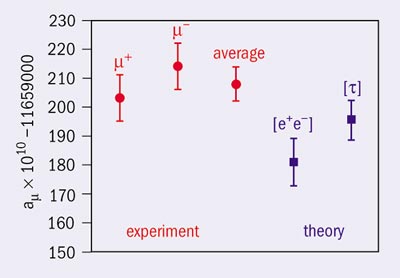
On 8 January the muon (g-2) collaboration, E821, which has been working for the past 15 years at the Brookhaven Alternating Gradient Synchrotron to measure the anomalous magnetic moment of the muon, released their final result, their first for the negative muon. The new result, which has been submitted to Physical Review Letters, has a relative precision of 0.7 parts per million (ppm), and as expected from CPT symmetry agrees well with the collaboration’s earlier 0.7 ppm measurement for the positive muon (Bennett et al. 2004). The combined precision is 0.5 ppm, a factor of 14 more precise than the famous experiments done at CERN in the 1970s, which reached 7.3 ppm. There has been considerable interest in these measurements because of the potential sensitivity to new physics such as supersymmetry, which would show up as a difference between the Standard Model value and the experimental one.
The E821 experiment ran at Brookhaven between 1997 and 2001, and was conducted by a collaboration of scientists not only from the US but also from Germany, Japan, the Netherlands and Russia. It was led by co-spokespersons Lee Roberts of Boston University and the late Vernon Hughes of Yale University. The collaboration’s first precise measurement, which was reported in 2001, differed from the Standard Model value by 2.6 standard deviations (Brown et al. 2001). The Standard Model theory for g-2 is composed of contributions from the weak, the electromagnetic and the strong forces. While the contributions from the weak and electromagnetic forces can be calculated from first principles, the contribution from the strong force cannot, and must be determined using experimental data. The direct determination uses data obtained by colliding electrons and anti-electrons, and measuring the production of hadrons in the collision. The indirect method uses data from the decay of tau leptons into hadrons, along with the conserved vector-current hypothesis plus the appropriate isospin corrections. At present the two methods do not agree very well, and in light of this disagreement some physicists use only the direct method to determine the theoretical value.
After the first announcement was made in 2001, many theoretical and experimental physicists took a closer look at the predicted theoretical value for g-2. In October 2001 Marc Knecht and Andreas Nyffeler from the University of Marseille found a sign mistake in a piece of the hadronic contribution, which moved theory closer to experiment (Knecht and Nyffeler 2002). Since then, progress has been made on both the experimental and theoretical fronts. The new value for the negative muon differs from the latest direct theoretical value by 2.8 standard deviations, the combined value differs by 2.7 standard deviations (Davier et al. 2003), and the difference from the indirect determination is 1.4 standard deviations.
Further reading
H N Brown et al. 2001 Phys. Rev. Lett. 86 2227.
M Davier, S Eidelman, A Höcker and Z Zhang 2003 Eur. Phy. J. C 31 503.
M Knecht and A Nyffeler 2002 Phys.Rev. D65 073034.





